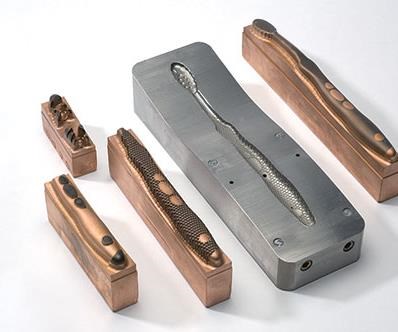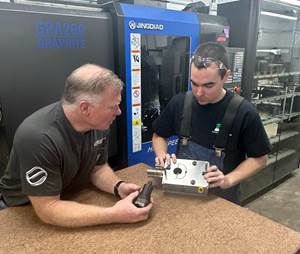Another Look at EDM Generator Technology
Advancements in fully digital sinker EDM generators offer benefits in mold maintenance, process efficiency and electrode wear.
Moldmakers benefit the most, by far, from fully digital sinker EDM generators. The digital technology has advanced the functionality of generators to the point where mold shops can now precisely control and manipulate the EDM spark. Such control allows them to produce components that reduce overall mold maintenance costs for their customers, while the shops themselves optimize their sinker EDM process efficiency and extend electrode life. Here is a look at the advanced functionalities of a digital EDM generator that can give moldmakers a competitive edge in those three areas:
Mold Maintenance
Molds that require less maintenance provide better part consis-
tency, produce a greater number of quality parts and have increased life. A good, friction-free mold surface finish can help, and advancements in generator technology can create such surfaces.
Fully digital generator technology that controls the spark and gap voltage during the EDM process provides options in burn parameters to achieve different levels of surface finish. Sinker EDM functionality in the generator settings and control software help reduce friction on the surfaces of molds, including inside any small details and ribs. Molds fill quicker, shaving seconds off the molding process. For manufacturers that make millions of injected-molded parts, this saves hours of cycle time and helps them produce hundreds of thousands of additional parts.
The resulting surface finishes from this EDM generator advancement also reduce the chance of residue sticking to the mold after the plastic is injected. This is a problem that grows worse after repeated injections, leading to uneven surface
finish on parts.
While a polished surface finish may seem ideal for every mold, this is not always the case. A highly polished finish requires that a great amount of pressure be used to inject the liquefied plastic into the mold. If the finish is too flat, or too smooth, the plastic suctions to the surface—the way two pieces of glass with water in between them stick together. This exceptionally strong suction effect slows the flow of plastic into the mold.
Additionally, greater ejection force is required to push the molded part out of the cavity of a highly polished mold, because the smooth surface causes it to stick in the same way. And if the newly formed part is still warm and a bit soft, the ejector pins will push into it and deform its surface.
This generator functionality smooths out the distance between the peaks and valleys on mold tooling surfaces, although not to a point where the peaks are eliminated. In a sense, it stretches the surface’s root mean square (RMS) value for roughness, while the roughness average (Ra) value remains the same. Because the peaks are more spread out, there is reduced surface sticking. This optimized surface finish also ensures that less force will be needed to eject a molded part from a mold. While tiny plastic particles may still be present on the part, the amount is not enough to consider the surface contaminated.
As a result of all of this reduced friction, molds can fill faster, and parts can be ejected quicker and with less effort. This means moldmakers need fewer ejector pins, which helps reduce machining and overall moldmaking lead times.
In operation, after rough-burning a mold cavity surface, a sinker EDM equipped with this friction-reducing functionality follows the standard finishing operation, but then activates the new function for the last two or three burn settings to impart the enhanced surface finish. The machine uses the same standard finishing electrode, and machining cycle time remains unchanged. This feature can also be used on existing mold tooling surfaces.
In addition to molding, other applications that would benefit from this type of surface finish are those in which the final part produced through EDM will come in contact with fluid. In such instances, the frictionless surface finish facilitates smooth and fast flow of those fluids.
Process Efficiency
Every moldmaker strives for higher cutting speeds and reduced electrode wear to increase overall mold production efficiency. However, as burn speed/spark power increases, so, too, does risk of damage to the part surface, especially in those applications where cavity undersizes are tight.
A big spark in the front of the sinker EDM electrode is acceptable, because the undersize can be controlled with the Z axis. However, on the sides of electrodes, the spark cannot be greater than the undersize, because it will destroy the sidewalls of the cavity. Therefore, the small undersize restricts the maximum power that can be used. Another special generator function allows certain sinker EDMs to vary the sizes of the sparks at the fronts and sides of electrodes, as opposed to using the same spark the whole way through a burn. An intelligent speed power generator with such functionality applies the electrical current only when and where necessary, eliminating the lateral sparking that historically creates disturbances on the sides of mold cavities, keeping electrode wear in check and optimizing cutting speeds. This functionality also allows the electrode to have maximum power in the front of the cavity without destroying the sidewalls or creating too big of a gap on the sides. This can potentially double or even triple material-removal rates over what is typically produced with small undersizes.
To extend electrode life, this functionality’s higher potential amperages and lower “on” times translate into less wear when roughing. It should be noted, however, that the same generator technology without this functionality still reduces electrode wear, but it does not increase the cutting speed as much.
Electrode Wear
The ability of an EDM electrode to produce and maintain details is a crucial part of the machining process, and that ability is affected by its wear resistance, particularly when intricate details or thin, deep ribs are involved. To achieve maximum EDM productivity, moldmakers need technology that allows them to reduce electrode erosion/wear, ideally by distributing the wear among multiple part cavities. Wear partitioning functionality in a sinker EDM generator can help.
In a typical sinker EDM operation, machining progresses according to a group of settings from the first mold cavity all the way to the last cavity, and then starts again on the first cavity with the next group of settings, and so on. The shapes of the cavities negatively change due to electrode wear between the first mold cavity and the last.
Wear partitioning offers an alternative for electrode wear compensation. It optimizes the use of electrodes, sharing the electrode wear among the mold cavities to increase part quality and dimensional consistency. And while actual burn times remain unchanged, this function can help reduce the use of consumables. This is especially beneficial when electrodes are complex and require a lot of machining time to produce.
Wear partitioning allows machining to occur setting by individual setting. The EDM determines this alternative setting distribution, as well as what electrode will be used when and in what sequence. It also indicates where machining should start in the cavities, when to switch the electrodes in and out, and what orbits to use with which electrode and for how long.
For example, a sinker EDM using this functionality can decide to enter the first cavity and orbit material out with the first electrode, then progress to the second and third finishing electrodes. Or it may rough out all the cavities with a roughing electrode, going from right to left, for instance, then switch to the semifinishing or finishing electrodes, moving back from left to right. Rough-cutting in one direction and semifinishing in the other in such a fashion eliminates wasted machine movement and helps shorten part cycle times.
Wear partitioning is only possible with fully digital EDM generator technology, however. The prerequisites for using it are that the mold cavities be equivalent in terms of depth, surface finish and required dimensional tolerances.
The three functionalities of fully digital EDM generators that have been described here can help mold shops optimize their operations in a range of different ways and thereby give themselves a leg up on their competition.
Related Content
Building Molds: Most Popular Reads of 2024
Dive into the most-viewed content for building your mold, including topics such as cutting tools, EDM, hot runners, additive manufacturing, mold materials, machining and mold components.
Read MoreMaintaining a Wire EDM Machine
To achieve the ultimate capability and level of productivity from your wire EDM on a consistent, repeatable and reliable basis, regular maintenance is a required task.
Read MoreFive-Axis Graphite Mill With Automation Debottlenecks Electrode Machining
Five-axis electrode cutting enabled Preferred Tool to EDM complex internal screw geometry on an insert that otherwise would have had to be outsourced.
Read MorePrecision Meets Innovation at IMTS 2024
After attending IMTS, it's clear that the integration of advanced technologies is ready to enhance precision, efficiency and automation in mold manufacturing processes. It’s a massive event, so here’s a glimpse of what the MMT team experienced firsthand.
Read MoreRead Next
How to Use Strategic Planning Tools, Data to Manage the Human Side of Business
Q&A with Marion Wells, MMT EAB member and founder of Human Asset Management.
Read MoreHow to Use Continuing Education to Remain Competitive in Moldmaking
Continued training helps moldmakers make tooling decisions and properly use the latest cutting tool to efficiently machine high-quality molds.
Read MoreReasons to Use Fiber Lasers for Mold Cleaning
Fiber lasers offer a simplicity, speed, control and portability, minimizing mold cleaning risks.
Read More























